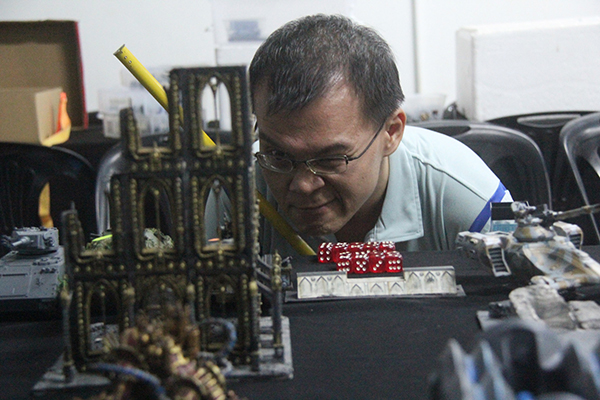
Jerome Wei checking line of sight during a recent game.
EVERY fortnight, they plot to wage war. Their sole intent – destroy whoever and whatever is unfortunate enough to cross their paths.
However, Wargamers Kuching is far from being a group of murderous malcontents with massive chips on their shoulders. They are actually a group of young Sarawakians who are into wargaming, particularly Warhammer 40,000 (also commonly known as 40K).
Wargaming is a general term which refers to recreational tabletop gaming where players engage in battle simulations – historical or fictional – to complete certain objectives.
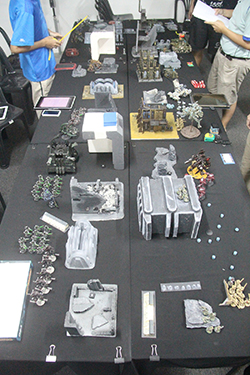
Buildings, terrain and units all laid out before the start of a game.
Popular hobby
The group meets up about once every two weeks at a trading card shop at Jalan Tun Jugah with ad hoc games organised every so often whenever schedules align and there is sufficient demand.
The richly detailed storylines and engaging backstories behind the 40K universe and the various armies and factions which populate it are one of the game’s strongest attractions and has spawn a number of spin-offs and collectibles in the form of video games, books, board and card games, as well as other miniature games.
In a nutshell, 40K takes place in the 41st millennium, 38,000 years in the future after Warhammer Fantasy Battle (another tabletop wargame also created by Games Workshop). Mankind has settled across the galaxy, mostly ruled by the theocratic regime called Imperium of Man which is on the brink of self-implosion.
The Imperium is involved in a war with a number of hostile forces — the Tau, Necrons, Eldar, Dark Eldar, Tyranids, Orks, and the daemons and mortal followers of the Chaos Gods – each with their own objectives and goals.
Fans of science-fiction and fantasy will recognise many of the mainstay stereotypes of the genres such as the mecha-like Tau and the humanoid aliens Eldar which bears resemblance to Elves.
Think Lord of the Rings meets Star Trek meets mecha and you would not be too far off in picturing the setting for the 40K universe.
Players literally get to choose their own adventure. Armed with retractable measuring tapes while referring to game manuals and specification sheets downloaded into smartphones and tablets, as well as the odd print-out, players pit their miniature armies against each other on a battlefield dotted with miniature buildings and various obstacles which change for every game.
The variations of gameplay are endless, so too, the combination of units and strategies employed to achieve mission objectives randomly determined by cards drawn from a shuffled pack.
While the gist of the main storyline and basic game mechanics have more or less remained the same since the game’s introduction in 1987, manufacturer Games Workshop periodically releases updates to the main rulebook as well as to the army specific rulebooks called codexes which not only reveals more details of the characters’ backstories but also keeps gameplay varied and fresh.
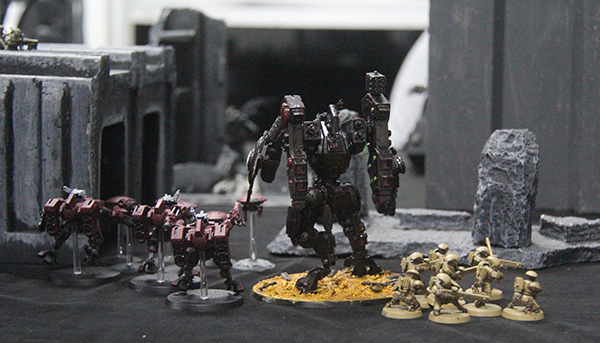
A large part of the game’s attraction is its engaging storyline and backstories of the myriad of characters which populate the 40K universe.
Origins
Wargamers Kuching first started about four years ago. One of its first members, Jerome Wei, introduced some friends to the hobby when they were playing role-playing games (RPGs). At that time, they were playing an RPG based on 40K.
One of their members got miniatures to experiment with, and they had a few practice games. Slowly, more members of the group started buying miniatures of their own and as more and more people joined in, games became more frequent.
Currently, group members purchase miniatures and other 40K paraphernalia mainly from hobby dealers in KL or directly from the UK, which can be costly as well as time-consuming. Nevertheless, this has not dampened their enthusiasm for the game.
Sometimes, the group allows proxies to be used in game play. Models which closely resemble certain miniatures are allowed to stand in but they must be close in size, shape and form.
Wei himself uses certain types of Tamiya tanks to substitute for 40K models. However, most players prefer to use the actual 40K models, some of which may require players to assemble themselves — and paint — if they so choose. “We like the hobby and the models enough to want to invest in them. We also want to have a collection that represents our hobbies. Some players buy models they will never use in games as they just want them for their collection,” Wei explained.
One of the things which attracted him to 40K was the storyline and backstories. He has a fondness for history, and so, finds himself drawn towards the military and infantry aspects of the game. Wei’s favourite army is the superhuman Space Wolves because they have a Viking-type backstory to them.
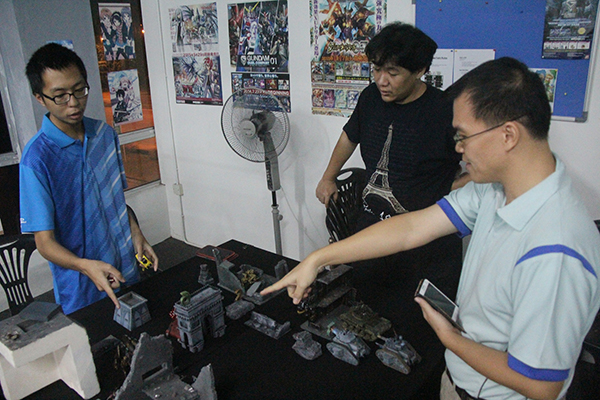
A game in progress.
Realistic gameplay
There are universal rules which apply to every unit as well as specific rules for particular units such as how far and fast they can move in a turn and weapon range. Each unit has its own strengths and weaknesses for certain types of fighting and objectives, and players must decide which would be best to implement their gameplay strategies.
Rules of engagement and gameplay takes into account many of the logic rules which apply during actual warfare such as line of sight, range between units, collateral damage from indirect hits, and troop morale.
Outcome – good or bad – is determined by the cast of the die. For example, if a certain number of a unit has been decimated during a single attack, the die must be cast to determine how much this has affected the unit’s morale (morale check).
Green discs of varying sizes called blast markers are used to measure range of effect from point of contact for specific weapons. For example, if a player were to aim an attacking unit, equipped with a flamethrower, right into the centre of an enemy platoon, the corresponding blast marker would be used to determine how many individual enemy units in the said platoon would be eligible for damage.
Terrain also factors into gameplay. For example, larger units may be hindered by narrow distance between buildings and may not be able to maneuver as quickly through certain terrain.
40K is not played on a fabricated or conventional board. Although Games Workshop does make and sell terrain kits, players often utilise or recycle materials such as styrofoam and cardboard to create a whole range of terrain settings including bases, ruins, buildings, forests, rock formations, craters and mountains.
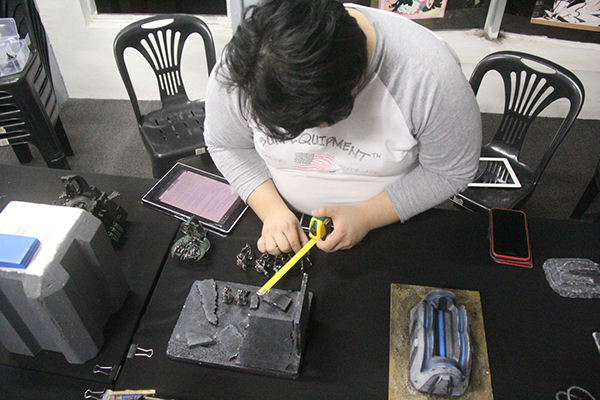
A player uses a retractable measuring tape to arrange his troops, while referring to game manuals and codexes downloaded into digital devices.
Addictive
Depending on the mission cards drawn by each player, a typical game between two players usually takes a few hours. A third party, not involved in the battle, will set up the battlefield any way they see fit, adding another layer of variability to gameplay as the two combating players will formulate their strategies based on how the terrain may help or hinder their armies.
For games that have particularly tough objectives, players may choose to settle on a cut-off time with the player with the highest scores and/or closest to achieving their missions being determined as the winner – otherwise, the game may potentially go on for hours more or even days.
Wei recalled that games had finished as late as 1:30 or 2.00 the next morning.
Remington Ling is one of the more experienced members of Wargamers Kuching, having been in the group since its very beginning. He was one of the first to start buying and assembling his own miniatures.
“I was in KL with a friend. We saw some kits and I decided to buy one. First time I saw it, I thought it was a single piece but then it came out of the box in bits and pieces.
“I had to learn how to assemble them and later how to paint them from Jerome. It was trial by fire. If it works, it works, if it doesn’t work, you need to change. You live, you learn. This hobby if you don’t try, you wouldn’t know.
“When I first started, I though this hobby was difficult and complicated but now for me, I can say it is easy. Nothing is hard if you put your mind to it,” he said.
Despite their relatively small size, the miniatures used in the game can be quite elaborate, taking hours or even a few days to put together and paint depending on how big or complex the unit is, Remington shared.
Some players also spend a lot of time hand-painting their models to look as realistic as possible.
He has spent about RM10,000 on this hobby so far, which in his opinion, is quite reasonable as players get a lot of mileage out of their investments.
“The moment you assemble and paint the models, they will always be there for you. The only thing which changes is the rulebook edition. The 40K models will not change. You can use them over and over again. Other games go through cycles and everytime the cycle changes, you have to buy new items which can be quite expensive,” he pointed out.
For those thinking of buying their own miniatures to start playing the game, Remington said they could expect to spend RM500 to RM1,000 to put together a decent starter army. However, it should be noted that Wargamers Kuching also has a community resource chest stocked with miniatures which players can utilise to create their own armies.
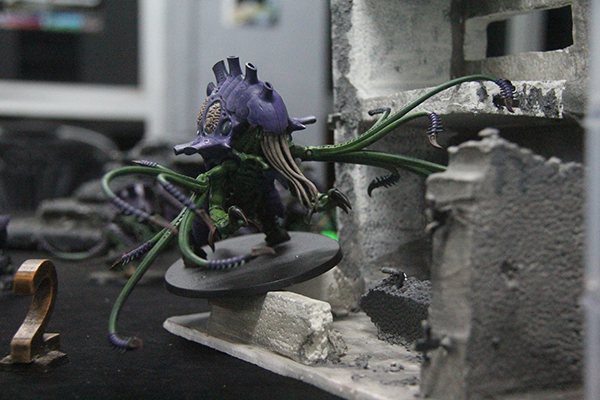
A large part of the game’s attraction is its engaging storyline and backstories of the myriad of characters which populate the 40K universe.
Interactive
Wei acknowledged part of the fun of the game comes from seeing how different people respond to different situations.
“This hobby is a healthy way to get to know and interact with other people. In this game, you have to talk to your opponent because you have to explain what your army is doing. From there, you can get a good sense of what kind of person and player your opponent is – how they make decisions, whether they are risk takers and so on,” he said.
“We don’t play our armies against each other to spite or belittle other people. We want to have a good time playing with our opponent because we know each other. Some of us are friends while some of us are more acquaintances but this is a good way for us to get to know each other better.”
To find out more, visit Wargamers Kuching at https://www.facebook.com/groups/wargamerskch.
